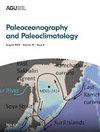High Productivity at High Latitudes? Photosynthesis and Leaf Ecophysiology in Arctic Forests of the Eocene
IF 3.2
2区 地球科学
Q2 GEOSCIENCES, MULTIDISCIPLINARY
引用次数: 0
Abstract
The Arctic forests of the Eocene, which thrived under elevated CO2, a temperate climate, high precipitation and annually extremely different daylengths, represent a quite spectacular no‐analogue habitat of Earth's greenhouse past. The aim of this study was to improve our understanding of the ecophysiology of Arctic broad‐leaved deciduous forests of the Eocene, by analyzing leaf photosynthesis and tree productivity based on gas exchange modeling for two fossil Eocene sites, Svalbard and Ellesmere Island. For this, a single‐leaf photosynthesis model that includes heat transfer and leaf senescence was derived. Environmental conditions were based on available palaeoclimate data and a CO2 level of 800 μmol/mol. Additionally, different light regimes (diffusivity and transmissivity) were considered. With this model, annual photosynthesis was calculated on the basis of annual temperature and day lengths (derived by celestial mechanics). To obtain productivity of a whole deciduous broad‐leaved tree, the single leaf data were then upscaled by a canopy model. The results indicate that productivity was enhanced at both high latitude sites by elevated CO2, temperature of the growing season and high maximum daylength (24 hr) during late spring and early summer. With productivity values about 30%–60% higher as for a mid‐latitude continental European forest, the results indicate a potential for high productivity at the Eocene polar sites which is in the range of extant tropical forests. In contrast to speculations, no evidence for a selective advantage of large leaf size—as shown by various fossil leaves from high latitude sites—could be found.高纬度地区生产率高?始新世北极森林光合作用与叶片生理生态
始新世的北极森林,在二氧化碳浓度升高、气候温和、高降水和每年极端不同的白天长度的条件下茁壮成长,代表了一个非常壮观的地球温室过去的栖息地。本研究的目的是通过对两个始新世化石遗址——斯瓦尔巴群岛和埃尔斯米尔岛的叶片光合作用和树木生产力进行气体交换模型分析,以提高我们对始新世北极阔叶落叶森林生态生理的认识。为此,我们推导了一个包含热量传递和叶片衰老的单叶光合作用模型。环境条件以现有古气候资料为基础,CO2浓度为800 μmol/mol。此外,还考虑了不同的光状态(扩散率和透射率)。在这个模型中,年光合作用是根据年温度和日长(由天体力学推导)来计算的。为了获得整棵落叶阔叶树的生产力,我们利用冠层模型对单叶数据进行了放大。结果表明,在春末夏初,CO2浓度升高、生长季节温度升高以及最大日长(24小时)增加都对两个高纬度站点的生产力有促进作用。生产力值比中纬度欧洲大陆森林高30%-60%,表明始新世极地遗址在现存热带森林范围内具有高生产力的潜力。与猜测相反,没有证据表明大叶子有选择优势——正如来自高纬度地区的各种树叶化石所显示的那样。
本文章由计算机程序翻译,如有差异,请以英文原文为准。
求助全文
约1分钟内获得全文
求助全文
来源期刊

Paleoceanography and Paleoclimatology
Earth and Planetary Sciences-Atmospheric Science
CiteScore
6.20
自引率
11.40%
发文量
107
期刊介绍:
Paleoceanography and Paleoclimatology (PALO) publishes papers dealing with records of past environments, biota and climate. Understanding of the Earth system as it was in the past requires the employment of a wide range of approaches including marine and lacustrine sedimentology and speleothems; ice sheet formation and flow; stable isotope, trace element, and organic geochemistry; paleontology and molecular paleontology; evolutionary processes; mineralization in organisms; understanding tree-ring formation; seismic stratigraphy; physical, chemical, and biological oceanography; geochemical, climate and earth system modeling, and many others. The scope of this journal is regional to global, rather than local, and includes studies of any geologic age (Precambrian to Quaternary, including modern analogs). Within this framework, papers on the following topics are to be included: chronology, stratigraphy (where relevant to correlation of paleoceanographic events), paleoreconstructions, paleoceanographic modeling, paleocirculation (deep, intermediate, and shallow), paleoclimatology (e.g., paleowinds and cryosphere history), global sediment and geochemical cycles, anoxia, sea level changes and effects, relations between biotic evolution and paleoceanography, biotic crises, paleobiology (e.g., ecology of “microfossils” used in paleoceanography), techniques and approaches in paleoceanographic inferences, and modern paleoceanographic analogs, and quantitative and integrative analysis of coupled ocean-atmosphere-biosphere processes. Paleoceanographic and Paleoclimate studies enable us to use the past in order to gain information on possible future climatic and biotic developments: the past is the key to the future, just as much and maybe more than the present is the key to the past.
 求助内容:
求助内容: 应助结果提醒方式:
应助结果提醒方式:


